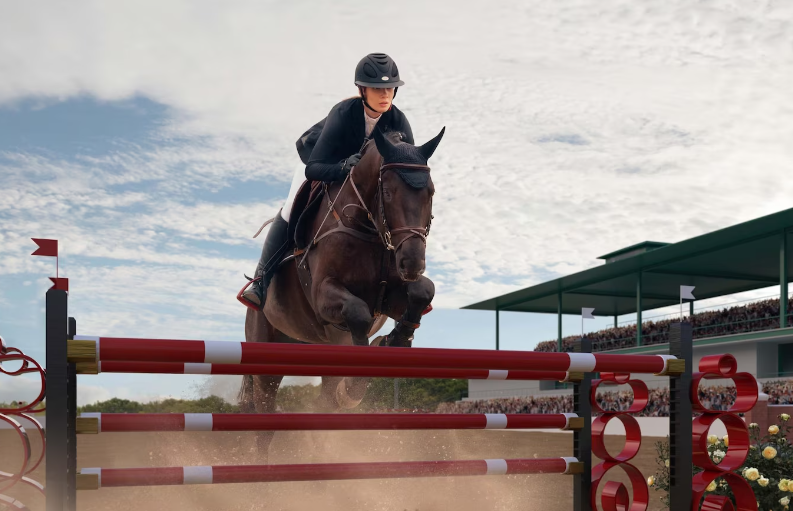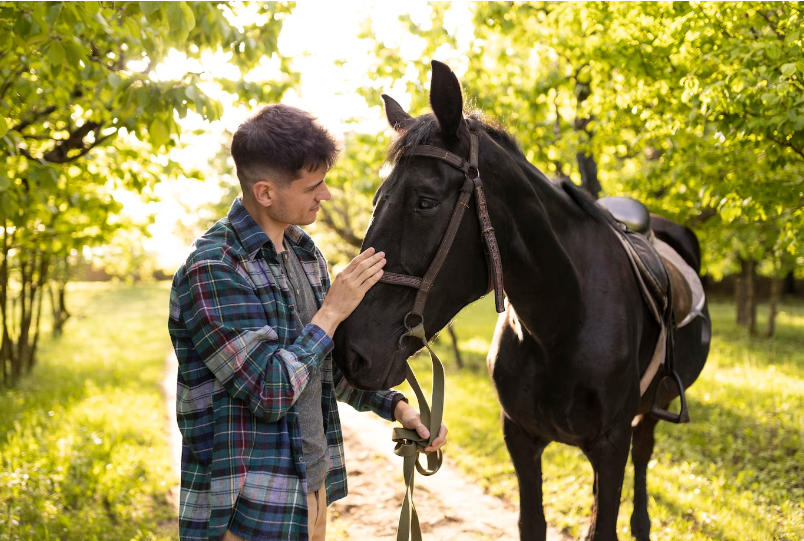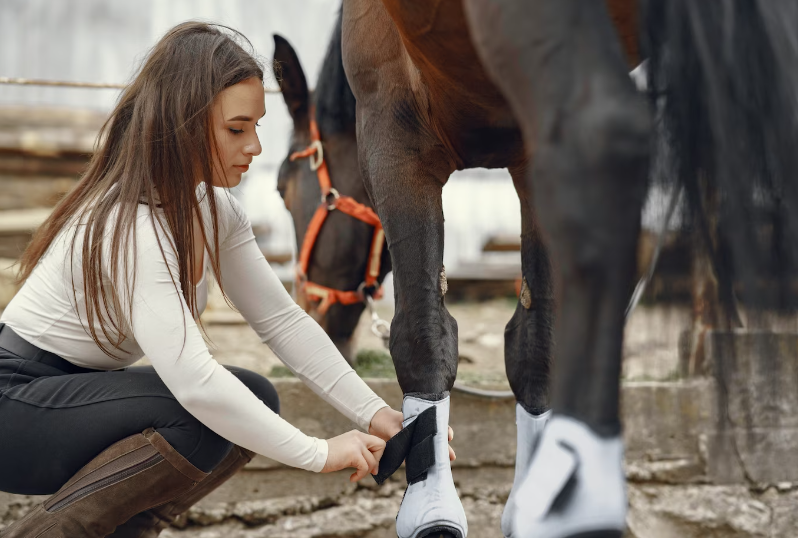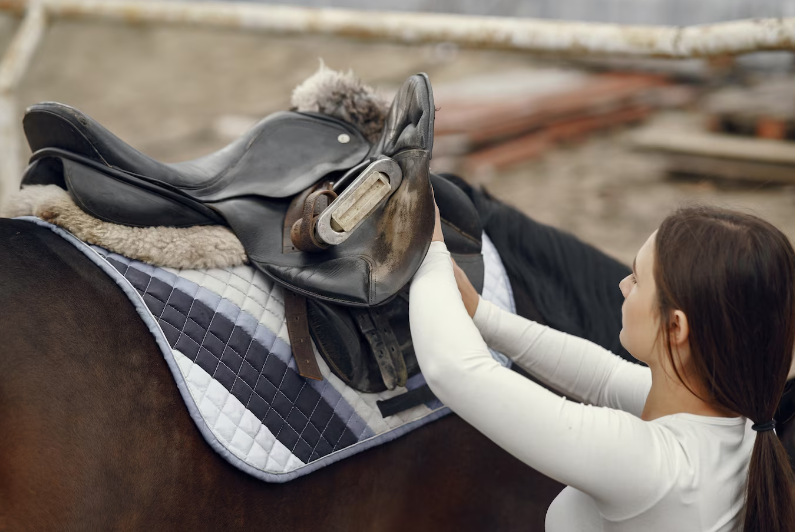Essential Groundwork Exercises for Building a Strong Bond with Your Horse

Developing a strong bond with your horse is crucial for a successful and enjoyable partnership. Whether you aim to compete in horse shows or simply want to build a strong and trusting relationship, horse groundwork exercises are the foundation of effective communication and understanding between you and your equine companion.
Horse behavior training through groundwork exercises allows you to establish leadership and gain the respect of your horse. These exercises focus on building a solid foundation of trust, establishing boundaries, and enhancing your horse’s responsiveness to your cues. By engaging in regular groundwork, you’ll not only enhance your horse’s training but also create a deeper connection based on mutual trust and respect.
Equine foundation training includes a variety of exercises that target different aspects of your horse’s physical and mental abilities. From basic leading and lunging exercises to more advanced tasks such as desensitization and obstacle courses, each exercise contributes to building your horse’s confidence, improving their obedience, and enhancing their overall well-being.
Groundwork exercises also provide an opportunity to assess and address any behavior issues or gaps in your horse’s training. By working on these exercises regularly, you can identify areas that need improvement and develop strategies to address them. This will not only improve your horse’s behavior but also help build their trust in you as their handler and leader.
Content:
The Importance of Groundwork
Equine foundation training is the process of teaching a horse basic ground handling skills before riding or driving. This includes teaching the horse to lead, stand quietly, tie, groom, and pick up its feet.
Groundwork is an essential component of horse behavior training. It helps establish a strong bond and trust between the horse and the handler, as well as develop mutual respect and clear communication.
Benefits of Groundwork
- Improved obedience: Through groundwork exercises, horses learn to respond to cues and commands from the handler, leading to improved obedience and cooperation.
- Enhanced safety: Basic ground handling skills help ensure the safety of both the horse and the handler. A well-trained horse is easier to handle and less likely to exhibit dangerous behaviors.
- Building trust: Spending time on groundwork helps build trust and strengthens the relationship between the horse and the handler. It establishes a foundation of communication and understanding.
Types of Groundwork Exercises
There are various exercises that can be included in equine foundation training. Some common ones include:
- Leading exercises: Teaching the horse to walk, stop, and turn on command while maintaining a respectful distance.
- Desensitization exercises: Introducing the horse to different objects, sounds, and sensations to minimize spooking and increase confidence.
- Circling exercises: Practicing lunging or longeing to improve balance, responsiveness, and respect for personal space.
- Obstacle courses: Setting up obstacles such as poles, cones, or tarps to challenge the horse and improve coordination and willingness to try new things.
By incorporating groundwork into your training routine, you lay the foundation for a strong and trustworthy partnership with your horse. Remember to be patient, consistent, and always prioritize the safety and well-being of both yourself and your equine companion.
Establishing Trust and Respect
Establishing trust and respect between you and your horse is crucial for building a strong bond. Proper horse behavior training and horse groundwork exercises can help you achieve this.
When working with your horse on the ground, focus on basic ground handling exercises that teach your horse to respect your personal space and listen to your cues. Start by teaching your horse to yield to pressure by gently applying pressure to different parts of their body and rewarding them when they respond appropriately. This will help establish your leadership and build trust.
Another important exercise is teaching your horse to move their hindquarters and forequarters on command. This not only helps improve their coordination, but also teaches them to pay attention to your cues and respect your authority.
Using positive reinforcement techniques such as treats or verbal praise can also help reinforce good behavior and create a positive association with training. Remember to always be patient and consistent with your horse, as building trust and respect takes time and effort.
By consistently working on these horse groundwork exercises and building a foundation of trust and respect, you will establish a solid partnership with your horse that will carry over into riding and other activities.
| Benefits of Establishing Trust and Respect: |
|---|
| 1. Improved communication between you and your horse. |
| 2. Increased safety for both you and your horse. |
| 3. A more willing and cooperative horse. |
| 4. Building a strong foundation for further training and bonding. |
Starting with Basic Groundwork
Before diving into more advanced horse groundwork exercises, it is important to establish a solid foundation with basic ground handling. This initial training sets the stage for a strong bond between you and your horse.
The Importance of Basic Ground Handling
Basic ground handling is the first step in equine foundation training. It helps establish trust, respect, and communication between you and your horse. By working on basic groundwork exercises, you lay the groundwork for more advanced training in the future.
During basic ground handling, you will teach your horse to respond to various cues, such as pressure on the halter or lead rope. This helps your horse understand and respect your personal space, making handling and grooming safer and easier for both of you.
Basic groundwork also helps with desensitization, getting your horse accustomed to different objects, sounds, and movements. This is especially important for young or inexperienced horses who may be easily spooked or nervous.
Key Groundwork Exercises
There are several essential groundwork exercises that you can start with:
- Leading and halting: Teach your horse to walk calmly beside you and stop when asked.
- Back up: Teach your horse to move backwards on command; this is useful for creating space and establishing boundaries.
- Circles and turns: Practice guiding your horse in circles and turns to improve their responsiveness and flexibility.
- Desensitization: Introduce your horse to different objects and sounds, gradually increasing their tolerance and confidence.
- Ground tying: Teach your horse to stand still and wait without being tied or held.
Consistency and patience are key when working on basic groundwork. Take the time to establish clear communication and build trust with your horse. Remember to always reward your horse for correct responses and progress at a pace that suits both of you.
Leading Exercises
Leading exercises are an essential part of equine foundation training. These exercises not only help to establish a strong bond between you and your horse but also teach them how to follow your leadership and respect your cues. Proper horse leading is crucial for their safety and the safety of those around them.
Why is Leading Training Important?
Leading training is an important component of horse behavior training and groundwork exercises. It helps to build trust, establish boundaries, and promote good manners. When a horse is properly trained to lead, they are less likely to pull or resist, making handling and riding much safer and more enjoyable.
Types of Leading Exercises
There are several exercises you can practice to improve your horse’s leading skills:
| Exercise | Description |
|---|---|
| Walk, halt, and backup | Teach your horse to respond to your cues to walk, halt, and backup while staying by your side. |
| Circling | Practice leading your horse in circles at various speeds to improve their responsiveness and flexibility. |
| Obstacle course | Set up an obstacle course and lead your horse through it, teaching them to navigate different challenges. |
| Transitions | Practice transitions between different gaits while leading, teaching your horse to match your pace. |
These exercises should be practiced consistently and gradually increased in difficulty as your horse becomes more proficient. Remember to reward your horse for their efforts and progress, and always prioritize safety during training sessions.
Desensitization Training
Desensitization training is a crucial aspect of horse behavior training. It involves exposing your horse to different stimuli in a controlled and gradual manner to help them become more relaxed and confident in various situations.
By desensitizing your horse, you are preparing them to handle potentially frightening or stressful situations calmly. This is especially important for horses that are being trained for specific disciplines or activities like trail riding, shows, or competitions.
Benefits of Desensitization Training
There are several benefits to incorporating desensitization training into your horse groundwork exercises:
- Improved confidence: By gradually introducing your horse to various stimuli, you can help them build confidence and trust in you as their handler.
- Reduced fear and anxiety: Desensitization training helps horses overcome their instincts to react to potentially scary or overwhelming stimuli.
- Enhanced safety: A horse that is desensitized is less likely to spook or panic in unfamiliar situations, which can help prevent accidents.
- Increased responsiveness: Through desensitization training, horses learn to stay focused on you as their leader and respond to your cues more effectively.
How to Perform Desensitization Training
When practicing desensitization training, it is crucial to start with small and less intimidating stimuli and gradually progress to more challenging ones. Here are some steps to follow:
- Introduce the stimulus: Begin by showing the horse the stimulus from a distance, allowing them to observe it without feeling threatened.
- Move closer gradually: As the horse becomes more relaxed, move closer to the stimulus, always keeping an eye on their reactions.
- Touch or interact with the stimulus: Once the horse is comfortable with the presence of the stimulus, gently touch or interact with it to demonstrate that it is not a threat.
- Repeat and vary the exercise: Practice the exercise repeatedly, gradually increasing the intensity of the stimulus and introducing new ones to ensure thorough desensitization.
Remember, desensitization training should always be approached with patience and caution. Each horse is different, and it is essential to respect their individual limits and progress at a pace that suits them.
By incorporating desensitization training into your equine foundation training, you will lay the groundwork for a strong bond with your horse built on trust, confidence, and effective communication.
Advancing to Intermediate Groundwork
Once you have established a solid foundation in basic ground handling and horse behavior training, you can start advancing to intermediate groundwork exercises. These exercises will help you further develop your bond with your horse and enhance communication and trust between you.
Here are some key exercises to include in your intermediate groundwork:
- Lunging: Lunging is an excellent exercise to improve your horse’s responsiveness and obedience. Start by teaching your horse verbal cues for walk, trot, and canter, and then practice lunging in both directions. This will not only improve your horse’s physical fitness but also help you establish control and respect.
- Obstacle Course: Set up an obstacle course using cones, poles, and other objects to challenge both you and your horse. This will improve your horse’s coordination, confidence, and trust in you as their leader. Start with simple obstacles and gradually increase the difficulty as your horse progresses.
- Desensitization: Use various objects such as plastic bags, tarps, and umbrellas to desensitize your horse to unusual sights, sounds, and sensations. Start by introducing these objects gradually and rewarding your horse for staying calm and relaxed. This exercise will help your horse become more confident and less reactive in new or stressful situations.
- Back-up and Side-pass: Teach your horse to back-up and side-pass on command. These exercises improve your horse’s overall responsiveness and can be useful in various situations, such as navigating tight spaces or moving away from pressure. Start by applying light pressure and rewarding your horse for the correct response.
- Liberty Work: Once you have established a strong connection and trust with your horse, you can start practicing liberty work. This involves working with your horse without any physical connection or equipment. Focus on creating a partnership based on mutual respect and communication. This exercise will deepen your bond and help you understand your horse’s body language better.
Remember, always prioritize safety and take things at your horse’s pace. Consistency and patience are key to advancing your groundwork skills and building a strong bond with your horse.
Lunging Exercises
Lunging is a valuable exercise when it comes to building a strong bond with your horse. It allows you to work on both your horse’s physical fitness and his mental focus. By incorporating lunging exercises into your horse’s training routine, you can improve his obedience, balance, and overall responsiveness.
When starting lunging exercises, it is important to have a solid equine foundation training. Your horse should be comfortable with basic ground handling and should respond well to your cues. If your horse is not yet proficient in these areas, it is recommended to spend some time reinforcing these skills before attempting lunging exercises.
Once your horse is ready, you can begin introducing him to lunging. Start by attaching a lunge line to your horse’s halter or bridle and stand in the center of the ring or arena. Signal your horse to walk on by using a voice cue or a gentle tap on his hindquarters. As your horse begins to move forward, you can encourage him to transition into a trot or even a canter.
During lunging exercises, it is essential to maintain a consistent rhythm and speed. This will help your horse develop balance and coordination. You can use verbal cues and changes in body language to guide your horse’s movements and transitions.
It is important to remember that lunging is not just about physical exercise. It also provides an opportunity for mental stimulation and engagement. Incorporate various patterns and obstacles into your lunging sessions to keep your horse focused and engaged.
| Benefits of Lunging Exercises |
|---|
| Improves obedience and responsiveness |
| Enhances balance and coordination |
| Builds mental focus and concentration |
| Increases physical fitness and stamina |
| Promotes a trusting and respectful bond between horse and handler |
By incorporating lunging exercises into your horse’s training regimen, you can strengthen your bond with him and improve his overall athleticism. Remember to always prioritize safety and take things at your horse’s pace. With consistent practice, you’ll see great progress and a happier, more cooperative horse.
Hindquarter and Shoulder Control
Hindquarter and shoulder control is an essential aspect of horse behavior training and equine foundation training. By teaching your horse to yield to pressure and move their hindquarters and shoulders independently, you will establish a stronger bond and enhance your communication with your four-legged companion.
One of the groundwork exercises that can help improve hindquarter and shoulder control is the hindquarter yield. This exercise involves asking your horse to move their hindquarters away from pressure. Start by applying gentle pressure with your hand or a training stick behind the horse’s girth area. The horse should respond by stepping their hindquarters away from the pressure. Reward and praise your horse when they make the correct movement.
Another exercise is the shoulder-in movement. This exercise focuses on getting your horse to move their shoulders away from pressure, allowing for better control and coordination. Begin by applying light pressure with your hand or training stick on the horse’s shoulder. The horse should respond by moving their shoulders away from the pressure. Again, reward and praise your horse for their efforts.
It is important to practice these hindquarter and shoulder control exercises regularly to reinforce the desired behavior. Gradually increase the difficulty by asking for more precise movements and higher levels of collection. Consistency and patience are key in building a strong bond and improving the communication between you and your horse through these horse groundwork exercises.
| Hindquarter Control Exercise | Shoulder Control Exercise |
|---|---|
| Apply pressure behind the horse’s girth area and ask them to move their hindquarters away from the pressure. | Apply pressure on the horse’s shoulder and ask them to move their shoulders away from the pressure. |
| Reward and praise when the horse responds correctly. | Reward and praise when the horse responds correctly. |
| Practice regularly to reinforce the desired behavior. | Practice regularly to reinforce the desired behavior. |
Progressing to Advanced Groundwork
Once you and your horse have mastered the basic groundwork exercises and have established a strong foundation of trust and communication, you can start progressing to more advanced exercises. These exercises will further strengthen your bond with your horse and enhance your horse’s training.
1. Advanced Ground Handling Techniques
Advanced ground handling techniques involve refining your horse’s response to your cues and commands. This includes teaching your horse to yield their hindquarters, forequarters, and back up on command. These exercises improve your horse’s obedience and make them more responsive to your aids.
2. Desensitization Training
Desensitization training involves exposing your horse to various stimuli to help them become more confident and less reactive. This can include introducing your horse to different objects, sounds, and movements. Through gradual exposure and positive reinforcement, you can help your horse overcome their fears and teach them to trust you in challenging situations.
3. Liberty Training
Liberty training is a unique form of groundwork that allows your horse to work freely without any physical connection. This exercise builds on the trust and rapport you have developed with your horse, as they choose to follow your guidance and perform various tasks. Liberty training helps improve your horse’s focus, responsiveness, and overall connection with you.
Remember, as you progress to advanced groundwork exercises, it’s important to always prioritize your horse’s safety and well-being. Pay attention to their behavior and adjust your training approach accordingly. Consistency, patience, and positive reinforcement will help you continue building a strong bond with your horse.
Liberty Training
Liberty training is an advanced form of horse groundwork exercises that focuses on developing a strong bond and communication between the horse and the handler. It is a method of training that allows the horse to freely express its natural behaviors and instincts while still maintaining a respectful and trusting relationship with its handler.
During liberty training, the horse is given the freedom to move and make choices, while the handler acts as a guide and leader. The goal is to create a partnership based on understanding and mutual respect, rather than force or dominance.
Basic ground handling exercises, such as leading, circling, and backing up, are essential foundational skills for liberty training. These exercises help establish communication and boundaries between the horse and the handler, and build a solid foundation of trust and respect.
Liberty training also includes exercises that focus on horse behavior training, such as teaching the horse to come when called, follow the handler at a distance, and respond to verbal and visual cues. These exercises enhance the horse’s ability to understand and respond to the handler’s signals, even without the use of physical contact or equipment.
Liberty training can be a rewarding and enriching experience for both the horse and the handler. It allows for a deeper understanding of the horse’s natural behaviors and instincts, and creates a strong bond based on trust, respect, and effective communication.
Question and Answer:
What are some essential groundwork exercises for building a strong bond with your horse?
Some essential groundwork exercises for building a strong bond with your horse include lunging, desensitization, leading exercises, and ground tying.
How can lunging help strengthen the bond with your horse?
Lunging can help strengthen the bond with your horse by allowing you to work together and communicate effectively. It helps build trust and respect, and enables your horse to develop obedience and responsiveness to your commands.
What are some desensitization exercises that can be done with a horse?
Desensitization exercises can range from introducing your horse to different objects and sounds to touch sensitivity exercises. For example, you can lead your horse around and expose them to various stimuli such as plastic bags, umbrellas, or tarps, gradually increasing the level of intensity as they become more comfortable.
How important are leading exercises in building a strong bond with your horse?
Leading exercises are crucial in building a strong bond with your horse as they help establish your role as the leader. By teaching your horse to lead respectfully and obediently, you establish a foundation of trust and communication that can carry over into other aspects of your relationship.
What is ground tying and how does it contribute to building a strong bond with your horse?
Ground tying is when a horse is trained to stand still without being tied or held. It contributes to building a strong bond by reinforcing your horse’s trust in you and their willingness to stay by your side even without physical restraint. It is an advanced exercise that requires a high level of obedience and mutual understanding.
What are some essential groundwork exercises for building a strong bond with your horse?
Some essential groundwork exercises for building a strong bond with your horse include leading exercises, desensitization exercises, liberty exercises, and bodywork exercises.


